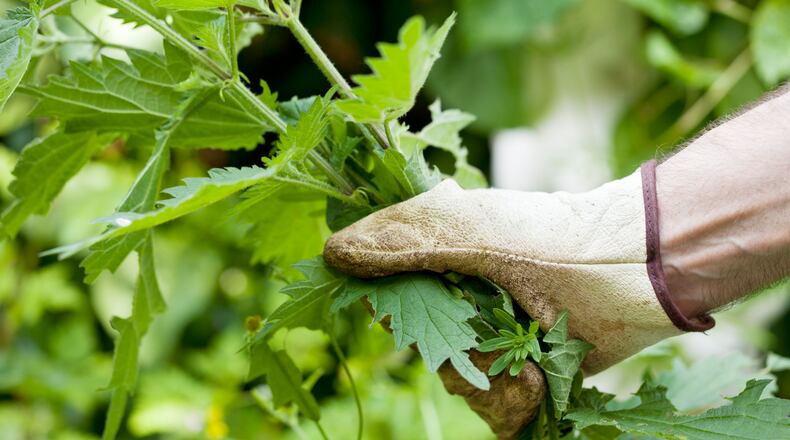Over centuries and millennia, through weather events and changes, environments have developed interdependent cycles of life. From soil to plant to pollinator to prey, one doesn’t exist without the other, including humans. Invasive plants can be a stick in the spoke of the local cycles, throwing things out of balance and wrecking the natural order. Often showing up earlier and staying later in the seasons, invasives can take over any available space and crowd out our original neighbors. Three of the most notorious offenders in Southwest Ohio are garlic mustard, amur honeysuckle, and Bradford (calleary) pear.
Making Way
The first step in welcoming natives is evicting the squatters. While the steps for removal vary by species, they all have one thing in common: it’s work.
The best method for garlic mustard is pulling before they seed. This is most easily done in the spring when the ground is wet. Then, dispose of the plants in a bag to contain the seeds — do not compost. The seeds can lie dormant for 2-5 years, waiting for their opportunity to invade. Your compost will just delay the process. Make sure your shoes are clean as well. If there is an upside, young plants are edible, adding some spice to recipes if you choose.
Expert tips for honeysuckle
There’s no edible upside to honeysuckle. Removal can be best described as an ongoing process. Ed McGowan, park manager at Buck Creek State Park, and Denis Conover, professor educator in the Department of Biological Sciences at the University of Cincinnati, offered several tips and tricks.
For herbicides, McGowan recommends Triclopyr (Garlon as an available name brand) as his go-to chemical treatment and following the manufacturer’s recommendation. The best time to spray is “whenever you see it,” he says with a laugh, but it varies by the season.
While plants are dormant during the winter, he recommends spraying the trunk or base, called basal spraying. This can be more effective with an “oil” carrier (following manufacturer directions) to help the solution penetrate the bark. He especially likes this when there are a lot of plants to treat.
If the plants are active, you can spray the leaves in a foliar application. McGowan advises “it doesn’t need to be drenched but wet as many of the leaves as you can.”
With foliar spraying, using a lower pressure with larger droplets is better than a mist. The larger droplets “hang around longer to allow the chemical time to work and prevent the spray from drifting.”
Just a few pumps in a normal hand sprayer is ideal, he says.
More aggressive and time consuming, but most effective is cutting and then immediately treating the stump with the herbicide.
“This get into the roots,” says McGowan.
If any regrowth occurs later, treat it with a foliar application. If your efforts are consistent you can get ahead of the growth. A downside is that you have piles of inedible branches. However, they do make great cover for wildlife.
Cutting or physically removing the plants without herbicide is the most labor-intensive.
“If it is young and you can revisit it, regularly cutting or even mowing can be effective,” says McGowan.
It’s the regrowth that makes it difficult to control. Preventing sunlight from reaching the cut stem is critical. Conover is testing non-toxic methods with his students.
In place of herbicides, “I prefer to cut them off at the base, then cover the stump with a folded black plastic garbage bag,” he says. “The plastic is then pinned to the ground with wire garden staples.” But it has to remove all light. ”If they are not completely covered they will resprout,” Conover warns.
Not-so-sweet Bradford Pears
The good news about Bradford pears is that you don’t have to worry about anyone intentionally planting new ones in Ohio. They were outlawed in 2023. The bad news is that they’re already here, spreading their quick-growing, weak limbs at every chance.
They grow easily in disturbed soil and seem to race honeysuckle to see which can take over an area quicker. Chainsaw operation and dropping trees is more than I’ll take on in this column. But if you have them, and you’re able, get rid of them.
Filling the space
Nature abhors a vacuum. Something will fill that open space. Once you’ve cleared out the invasives, we can finally get to the point: Ohio native plants. After clearing honeysuckle, Conover and his UC students reintroduce native species, “planting chokecherries, gray dogwoods and Arrowwood Viburnum” once the honeysuckle is removed.
The Ohio DNR has lists of plants to consider in place of these three offenders and other invasives online at https://ohiodnr.gov.
Devin Meister is a local outdoors and wildlife enthusiast and has a blog called “Average Guy Outdoors.” He is an Ohio University graduate. Reach him at meister.devin@gmail.com.
APRIL OHIO NATIVE PLANT MONTH EVENTS
April 14: Garlic Mustard Challenge
Fill bags of garlic mustard and earn swag from National Trails Parks and Recreation, ntprd.org/garlic-mustard-challenge-2025/
April 19: Carolyn Kimes Tree Seedling Giveaway
9 a.m. to 3 p.m. at the 2nd Street Market, metroparks.org
More: ohionativeplantmonth.org
About the Author


